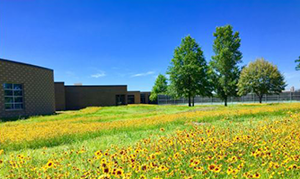Blue Valley North High School Prairie
Overland Park, Kansas

How does this project advance the three pillars of sustainability — social equity, economic vitality and environmental stewardship?
Once established, this project will allow for students of all backgrounds to be able to learn from and experience a native prairie ecosystem firsthand. Students will use the prairie as a place to collect data and make observations for ongoing classroom research in their science classes, or as a place of inspiration or observation for classes in the humanities. Students will use seed collection and propagation techniques to grow their own native plants to add to the prairie as needed. Science curriculum will include the identification of non-native species, and students will be involved in the removal of these species. As a permanent feature of the Blue Valley North (BVN) landscape, this prairie space will serve as an outdoor classroom for all teachers to use and will help students recognize and appreciate their native Kansas ecosystem.
Project Goals:
The goals of this project are to provide an ongoing, project-based learning opportunity for students to discover the importance of native Kansas ecosystems through the establishment and upkeep of a prairie habitat. Through this opportunity, students will gain understanding and experience in sustainable landscape design, plant identification, impact of native habitats on natural resources, seed collection and propagation, invasive species control, and public engagement and education.
Project Description:
Students and teachers at BVN used the design process to create a plan for developing a 0.72-acre prairie on school grounds. Students proposed concepts, presented to administration and local experts, created a tiered budget, and solidified ideas to build the prairie with the intent to impact the school and local community. As a student-driven endeavor, participants wrote and answered the research question: How might we increase awareness and understanding of native flora in our local community? In the initial phase of construction, easy-to-establish species were chosen and planted as cover crop. Currently trails are made of mown grass but plans for renovated trails and an outdoor classroom learning experience with educational signage are in the next phase. Students also plan to provide community outreach to the neighboring elementary school and retirement communities.
Community Benefits and Lessons Learned:
A native prairie at BVN impacts science students, elementary school students and community groups. Students benefit by studying the prairie, maintaining native grasses and trails, and collecting data on prairie flora. Elementary students benefit by experiencing prairie ecosystems and collaborating with BVN students to learn and create. BVN students will create interactive educational experiences while art students design installations and maintain signage for the prairie. In addition, students will partner with three retirement and assisted living communities within a half-mile of the school.
Funding Sources and Partnerships:
The BVN Prairie project has been funded thus far through a grant from the Blue Valley Center for Advanced Professional Studies. Another possible source of funding is the Blue Valley Education Foundation.
